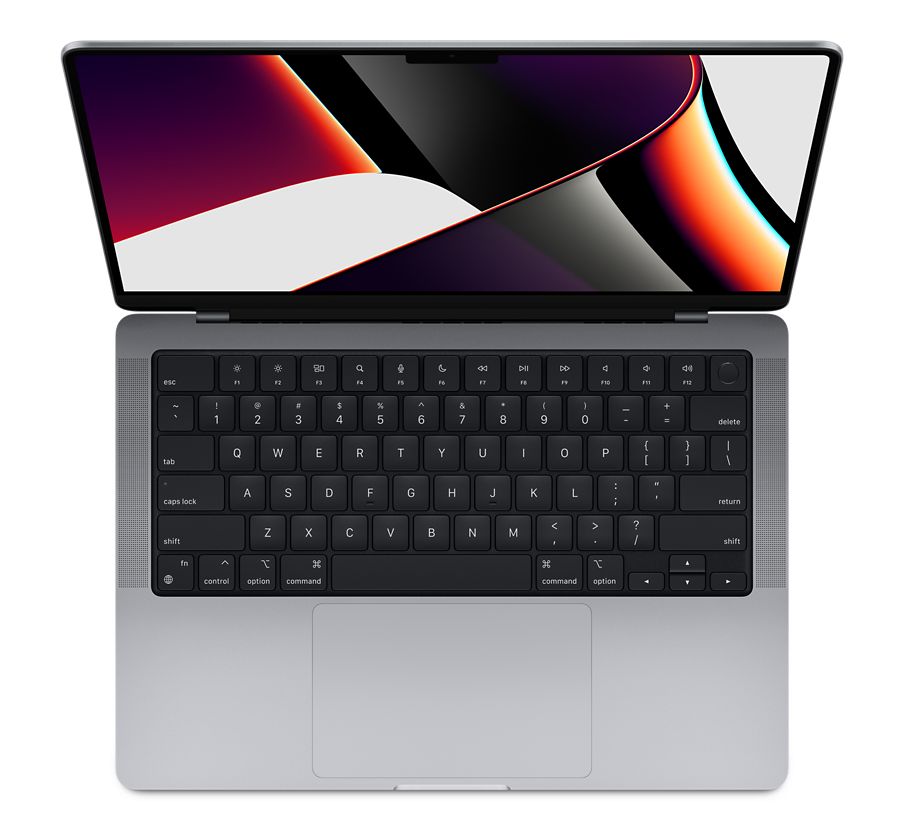iMore Verdict
Bottom line: Familiar, yet oh-so new, the latest MacBook Pro checks most of the boxes. Still, it's not for everyone, especially at its steep price points.
Pros
- +
Smooth Liquid Retina XDR display
- +
A keyboard with real function keys
- +
Solid feel throughout
- +
Customization galore
- +
1080p FaceTime HD camera
Cons
- -
Expensive
- -
Only two color choices
- -
No Face ID
- -
Divisive notch
- -
Still isn't user-repairable
You can always trust iMore.
In 2016, Apple introduced a radically redesigned MacBook Pro that featured an all-new butterfly keyboard and OLED Touch Bar. It also shipped with only USB-C ports for the first time. That year's model, and those through 2020, also saw the removal of the iconic MagSafe charging port and backlit Apple logo.
Though it remained the choice for many buyers by default, the fourth-generation MacBook Pro wasn't always well received.
Five years later, Apple finally listened to users and announced a MacBook Pro that looks and feels like ... a MacBook Pro. The 2021 14-inch MacBook Pro and second-generation 16-inch MacBook Pro are gems that reintroduce familiar favorites while also embracing new technology. The result is a solid machine that's the best Mac to date of the Apple silicon era.
Is it for you? That largely depends on your needs and pocketbook size.
MacBook Pro (2021): Price and availability
At launch, Apple's offering two pre-configured 14-inch MacBook Pro models and three 16-inch models. These are the laptops now available at Apple and through third-party retailers like Best Buy and Amazon. However, if you want a custom-built version, you might be waiting six to eight weeks at the time of this writing.
The 14-inch MacBook Pro starts at $1,999. If that number sounds even higher than usual for the MacBook Pro, you're correct. The still available 2020 13-inch MacBook Pro starts at $1,299. That $700 difference can't be overlooked. By contrast, the entry-level price on the 2021 16-inch MacBook Pro vs. the 2019 MacBook Pro is the same, $2,499.
You get 16GB of unified memory and 512GB of SSD storage on the cheapest 14- and 16-inch models. Both include the M1 Pro system-on-a-chip (SoC). Doubling the memory and storage on the 14-inch model increases the price to $2,599, while the same jump on the 16-inch model will cost $3,099. If you want the least expensive M1 Max version, you'll pay $3,099 and $3,499 for the 14-inch and 16-inch versions, respectively.
What's the most you can spend on the 16-inch model? One with an Apple M1 Max chip with 10-core CPU, 32-core GPU, 16-core Neural Engine, 64GB unified memory, and 8TB SSD storage will set you back $6,099.
MacBook Pro (2021): Hardware and design
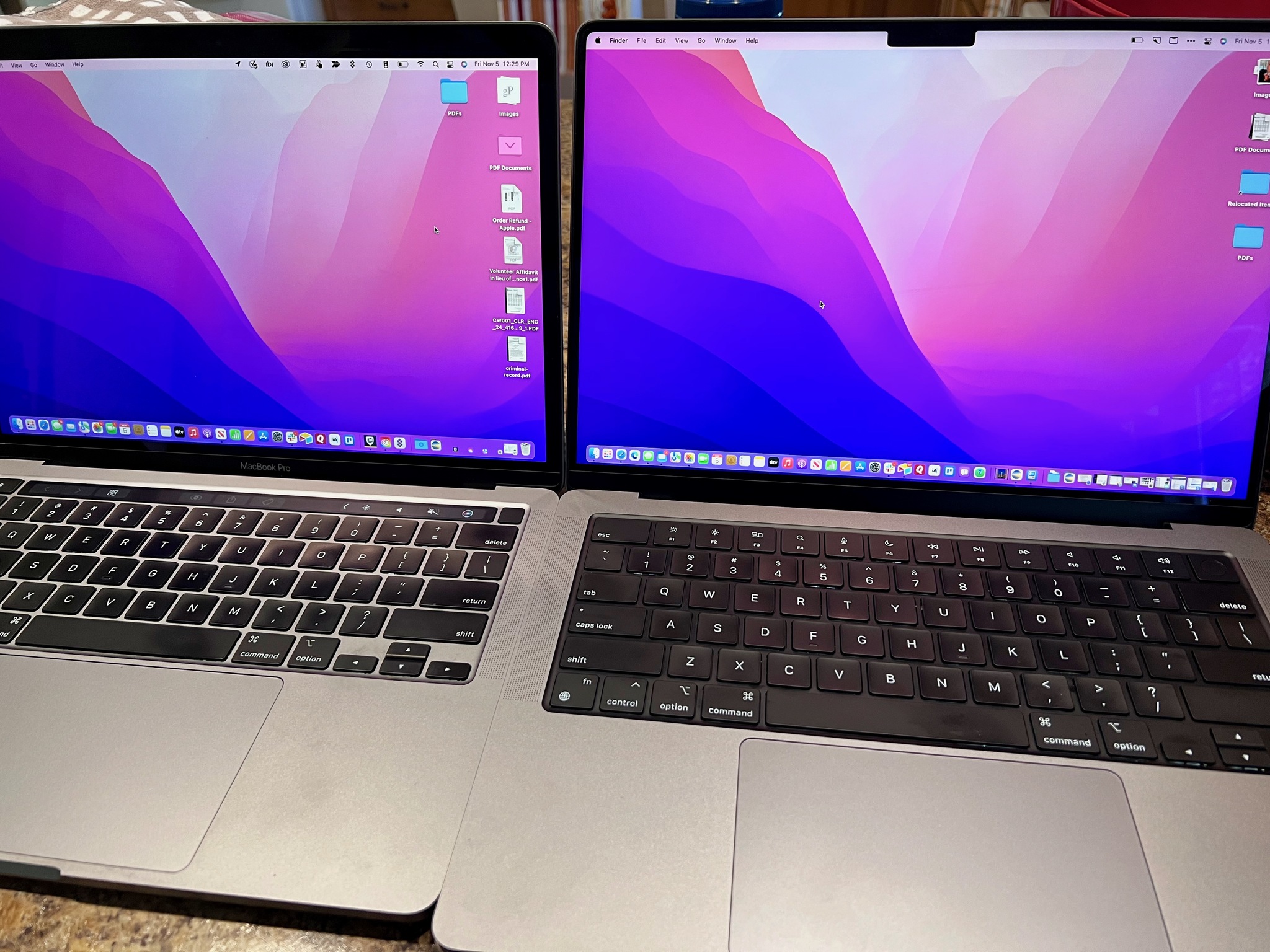
| Category | MacBook Pro (2021) |
|---|---|
| Operating System | macOS Monterey |
| Display | 14.2-inch (diagonal) mini-LED backlit display, 3024 by 1964 pixels16.2-inch (diagonal) mini-LED backlit display, 3456 by 2234 pixels |
| Processor | M1 Pro or M1 Max |
| Storage | 512GB/1TB/2TB/4TB/8TB |
| Memory | 16GB/32GB/64GB |
| Camera | 1080p FaceTime HD camera |
| Battery | Integrated 70-watt-hour lithium-polymer battery (14-inch)Integrated 100-watt-hour lithium-polymer battery (16-inch) |
| Power | Up to 17 hours Apple TV app movie playback (14-inch)Up to 21 hours Apple TV app movie playback (16-inch) |
| Dimensions | 12.31 x 8.71 x 0.61 inches (14-inch)14.01 x 9.77 x 0.66 inches (16-inch) |
| Weight | 3.5 pounds (14-inch)4.7 pounds (16-inch) |
| Colors | SilverSpace Gray |
For months, we've heard Apple was finally going to move beyond the 13-inch and 16-inch MacBook Pro models. The new 14-inch version, officially measuring 14.2-inches, provides an excellent middle ground, although it's a shame the company didn't reconsider and offer a 15-inch model again.
Some reviewers have argued there's not much of an overall size difference between the 13-inch and 14-inch models. This is true only with the height, which is 0.61-inches on both models. Beyond this, there's no denying the 14-inch model provides a much larger screen area than the smaller model. There's also the weight difference. You can feel the 1/2 pound difference between the models, although the increased depth and width are less noticeable.
I haven't had a chance to experience the 2021 16-inch MacBook Pro, but I've heard the overall size difference between it and the 2019 model is less noticeable beyond the weight. The newer model is 0.4 pounds heavier.
The 14-inch MacBook Pro measures 12.31 x 8.71 x 0.61 inches compared to the 11.97 x 8.36 x 0.61 inches found on the 13-inch model. The 2021 16-inch model is 14.01 x 9.77 x 0.66 inches versus the 14.09 x 9.68 x 0.64 inches found on the previous model.
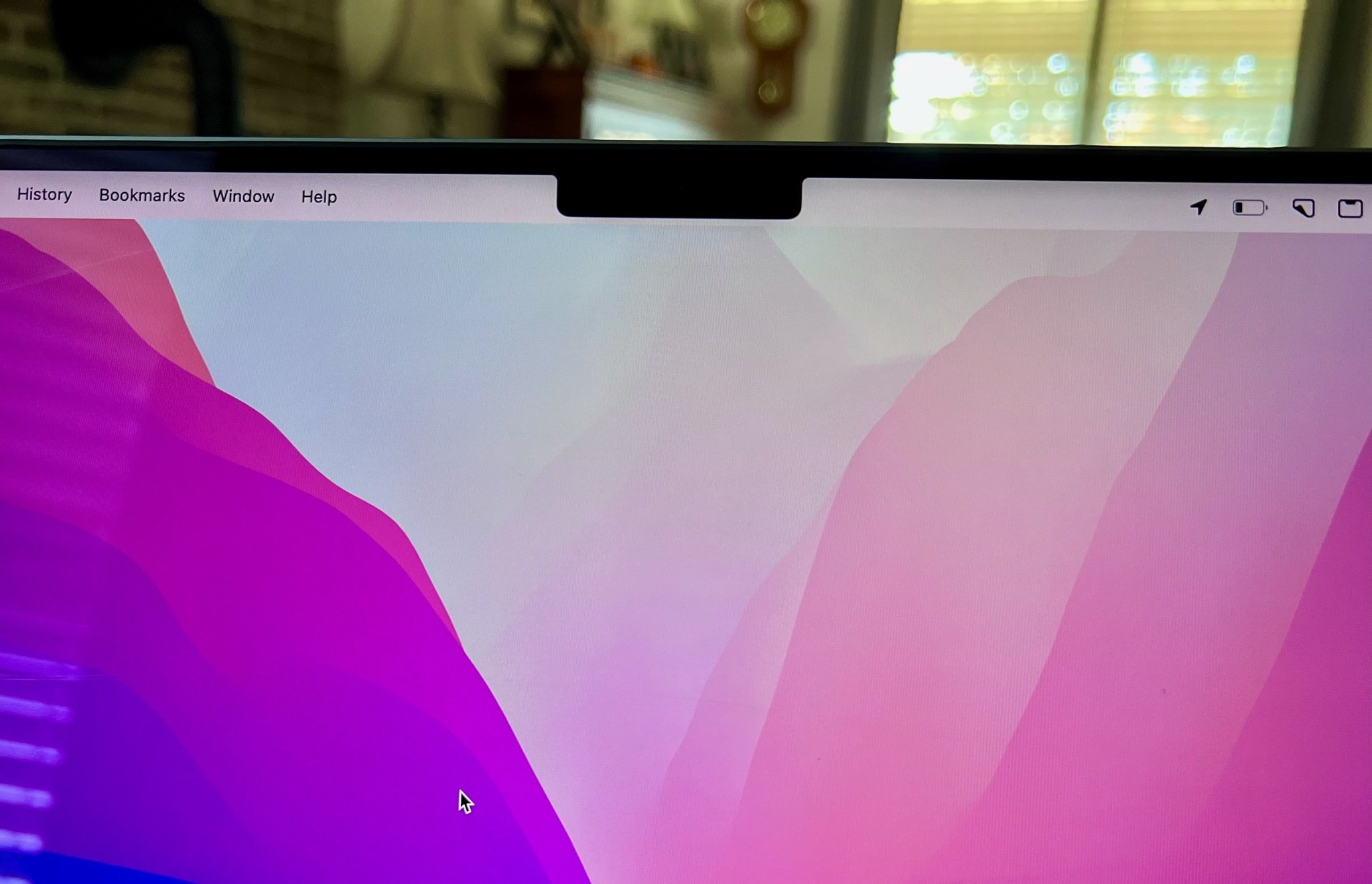
Once you move beyond size and weight, the 2021 MacBook Pros are noted for having slimmer bezels. It's a considerable improvement and (finally) allows the product lineup to match the look found on competitor products.
The slimmer bezel has led to a somewhat controversial change. For the first time, the MacBook Pro has a notch like the modern iPhone series before it. Of course, all buyers won't accept the MacBook Pro notch. And yet, during my testing, it hasn't bothered me in the slightest.
This feeling almost certainly has to do with how macOS Monterey handles it. Many apps (but not all) already adapt to the notch to make it less noticeable. Better still, there's already a free third-party solution, TopNotch, that hides it completely.
Once you move beyond size and weight, the 2021 MacBook Pros are noted for the slimmer bezels. It's a vast improvement and (finally) allows the product lineup to match the look found on competitor products.
Though some might not like the look, the notch has many more positives than negatives. The menu bar is higher on the screen because of the reduced bezels, thereby giving apps more room below. And thanks to design trickery, the notch goes away whenever you view a full-screen video or use full-screen mode.
What's most concerning about the notch isn't the look but whether it's even necessary. Unfortunately, the two reasons for having the notch on the iPhone, Face ID, and the TrueDepth camera, aren't present here. Regardless, we still get a better camera system that offers a 1080p resolution and a larger sensor (see below).

Apple finally put the unloved Touch Bar out of its misery by excluding it from the 2021 MacBook Pro. Instead, full-size physical function keys that include keyboard shortcuts have replaced the OLED strip on the top row of the keyboard. To the right, you'll still find a Touch ID button. It's much bigger than those on previous models. The Touch ID is entirely black with no backlighting, which tends to be frustrating at night in a dark room. It also services as a power button.
Beyond the new function key row and redesigned Touch ID, the rest of the MacBook Pro's Magic keyboard is similar to those found on more recent models. These keyboards finally did away with the controversial butterfly mechanism and now use a scissor-switch arrangement. The resulting input feels solid and natural, as it should be on a laptop. The Force Touch trackpad also remains the same and works as expected.
You might have heard the new MacBook Pro has multiple ports! The two models include three Thunderbolt 4 (USB-C) ports, which you can use for charging, a DisplayPort, and Thunderbolt 4 (up to 40Gb/s). There's also an HDMI port and SDXC card slot. Best of all, the laptops have a MagSafe 3 port for charging purposes. And yes, Apple has kept the 3.5mm headphone jack, which is now on the laptop's left side.
My favorite returning port is MagSafe. Like previous iterations, MagSafe has been designed so that a charging cable can pull away safely when it's accidentally tugged too hard. It's a feature unique to MacBook Pro and one Apple should have never removed (MagSafe also includes the familiar charging indicator light!).
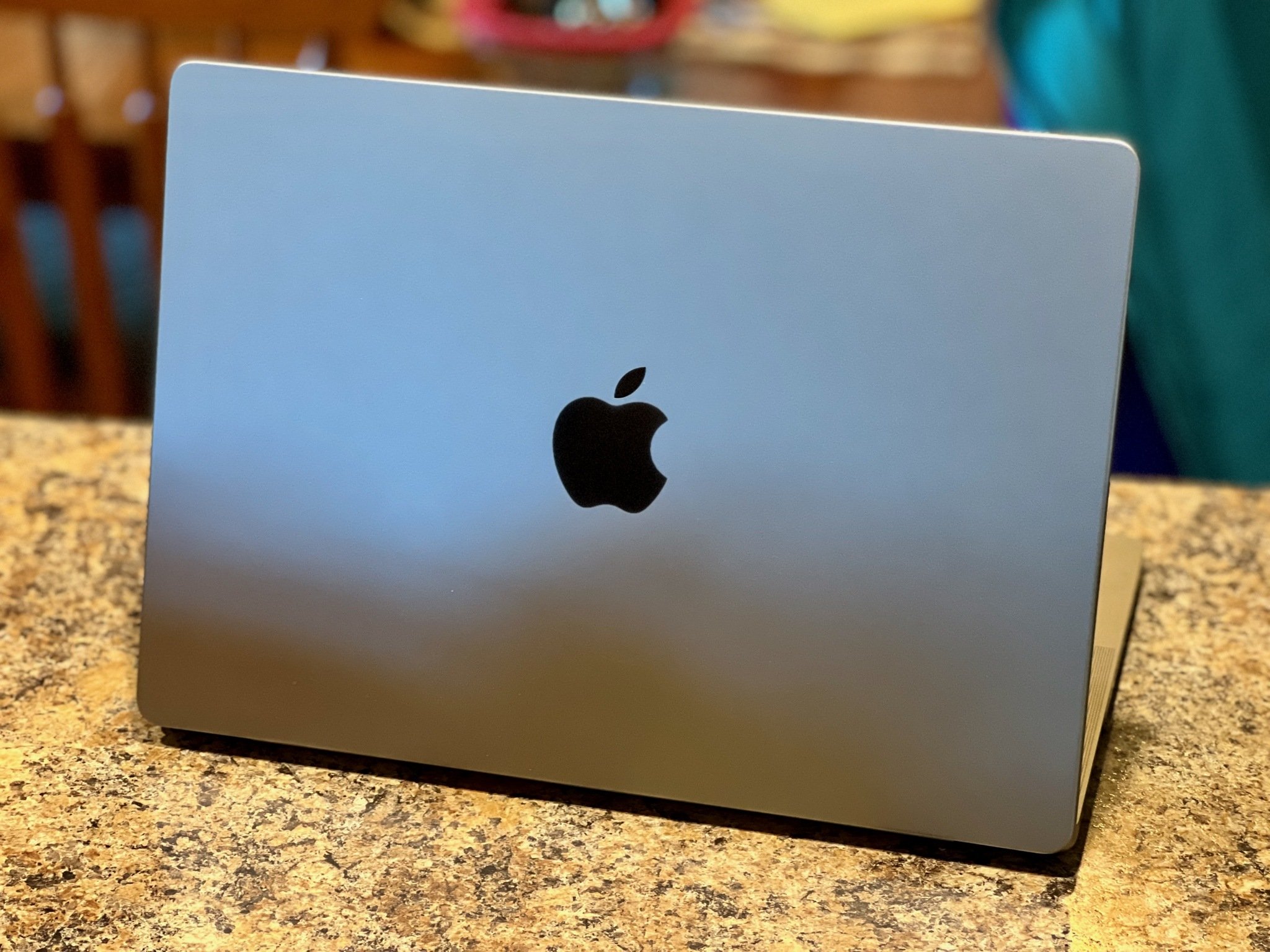
Including these ports, seven in all is only significant because Apple decided to remove most of them a half-decade ago. Now that they're back, we can finally ditch one of the best USB-C hubs or other dongles and feel once again like we're using a pro device.
Apple hasn't gone completely Back to the Future on us as a backlit Apple logo remains MIA. However, the logo is more prominent. And, in an attractive design move, the words MacBook Pro are now embedded on the bottom of the device.
Now would have been the perfect time for Apple to introduce a third color choice on the MacBook Pro. Unfortunately, it did not. You can still only purchase the product in silver and space gray, regardless of the size.
MacBook Pro (2021): Software and performance
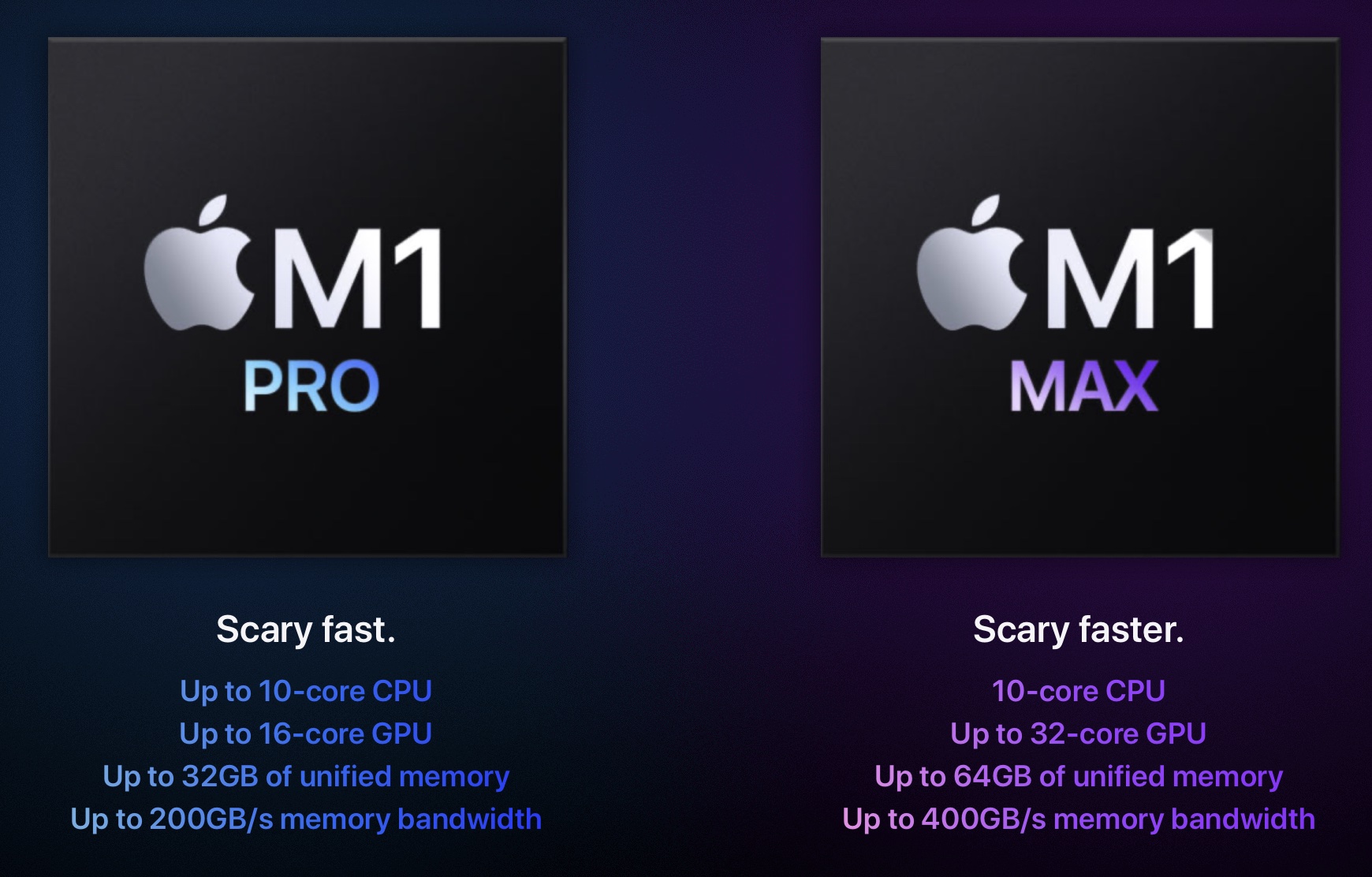
For months, the Apple rumor mill suggested the 2021 MacBook Pro would receive either an "M1X" or "M2" SoC. In reality, the company announced two new Apple silicon products, the M1 Pro and M1 Max.
The first Apple silicon, the M1, announced in 2020, was already an impressive piece of hardware and lives on in the 13-inch MacBook Pro and other devices. The M1 Pro and M1 Max each build off the M1 to make a great product even better.
The M1 Pro, which is in my 14-inch MacBook Pro review unit, has a dual-chip architecture that will support up to 32GB of unified memory and a bandwidth of 200GB/s. This is three times the bandwidth found on the M1. In addition, the M1 Pro offers up to a 10-core CPU with eight performance cores and two efficiency cores, up to 16-core GPU, and a 16-core Neural Engine. The M1 Max also includes a 10-core CPU. However, you also get up to 32-core GPU, 64GB of unified memory, and 400GB/s memory bandwidth.
The translation? The M1 Pro and M1 Max are both blazing fast and, in many respects, too powerful for most Pro customers. And yet, it's still great to see Apple push things to these levels for those who need these types of resources on a Mac laptop.
The Apple M1 Pro and M1 Max are why things run so smooth and snappy on the 2021 MacBook Pro. And yet, the look of everything pops even thanks to the Liquid Retina XDR display.
With ProMotion technology for adaptive refresh rates up to 120Hz, the 2021 MacBook Pro never takes a breath when doing basic tasks. When web browsing, for example, scrolling up and down a page is fast and smooth. This seamless movement is duplicated in word processing and spreadsheet apps and when watching videos on iTunes, Apple TV+, and YouTube.
Of course, a MacBook Pro is expected to do much more than basic computing. These are the machines most often used for photography, video, or other professional-grade creative work. From Cinema 4D to Final Cut Pro to Adobe Photoshop, there was nothing my entry-level 14-inch MacBook Pro couldn't handle, which proves that real creative experts will also have no problems, especially with even better specs. The new laptop also exceeds when performing music-related tasks with apps like Logic Pro.
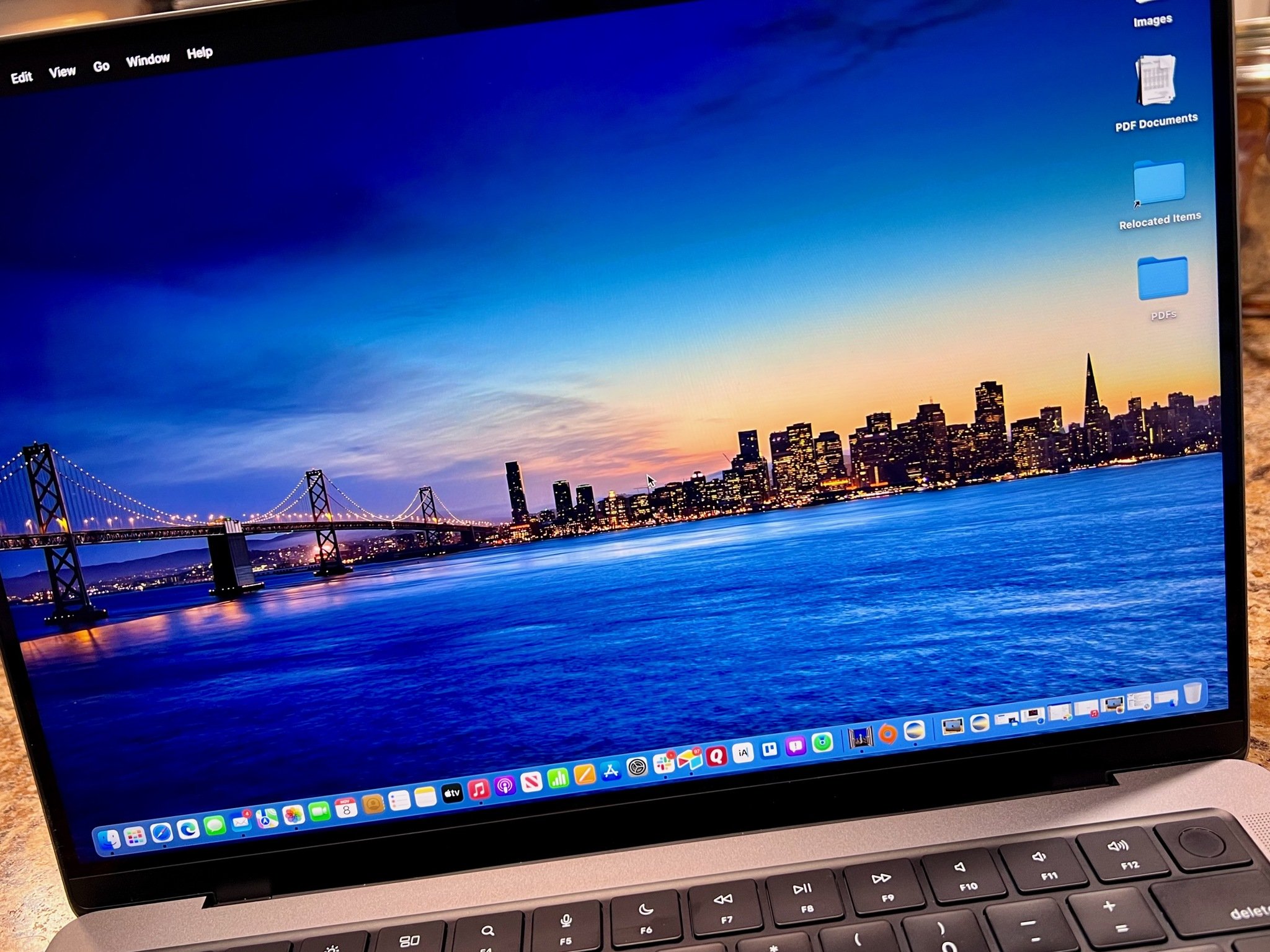
The Apple M1 Pro and M1 Max are why things run so smooth and snappy on the 2021 MacBook Pro. And yet, the look of everything pops even further thanks to the Liquid Retina XDR display. The display is gorgeous with the 3024-by-1964 native resolution at 254 pixels per inch on the 14-inch model and 3456-by-2234 native resolution at 254 pixels per inch on the 16-inch version. And thanks to the up to 1000 nits sustained (full-screen) brightness and 1600 nits peak brightness, the display is impressive no matter the time of day.
MacBook Pro (2021): Battery
Most rate the strength of a laptop battery by how long it works between charges. Another variant is determining how big a performance hit there is when moving between A/C to battery power. Apple silicon has positively affected both of these measurements on this year's MacBook Pro, although it's more noticeable on the larger of the two models.
This year's 16-inch MacBook Pro offers 21 hours of battery life compared to the paltry 11 hours between charges on the Intel-based 2019 model. By contrast, the 14-inch version offers 17 hours of video playback versus the 13-inch MacBook Pro's 20 hours.
Seventeen hours is nothing to sneeze at, especially when considering the final Intel-based 13-inch MacBook Pro only offered 10 hours between charges. And yet, it's somewhat a surprise the bigger version provides better battery life.
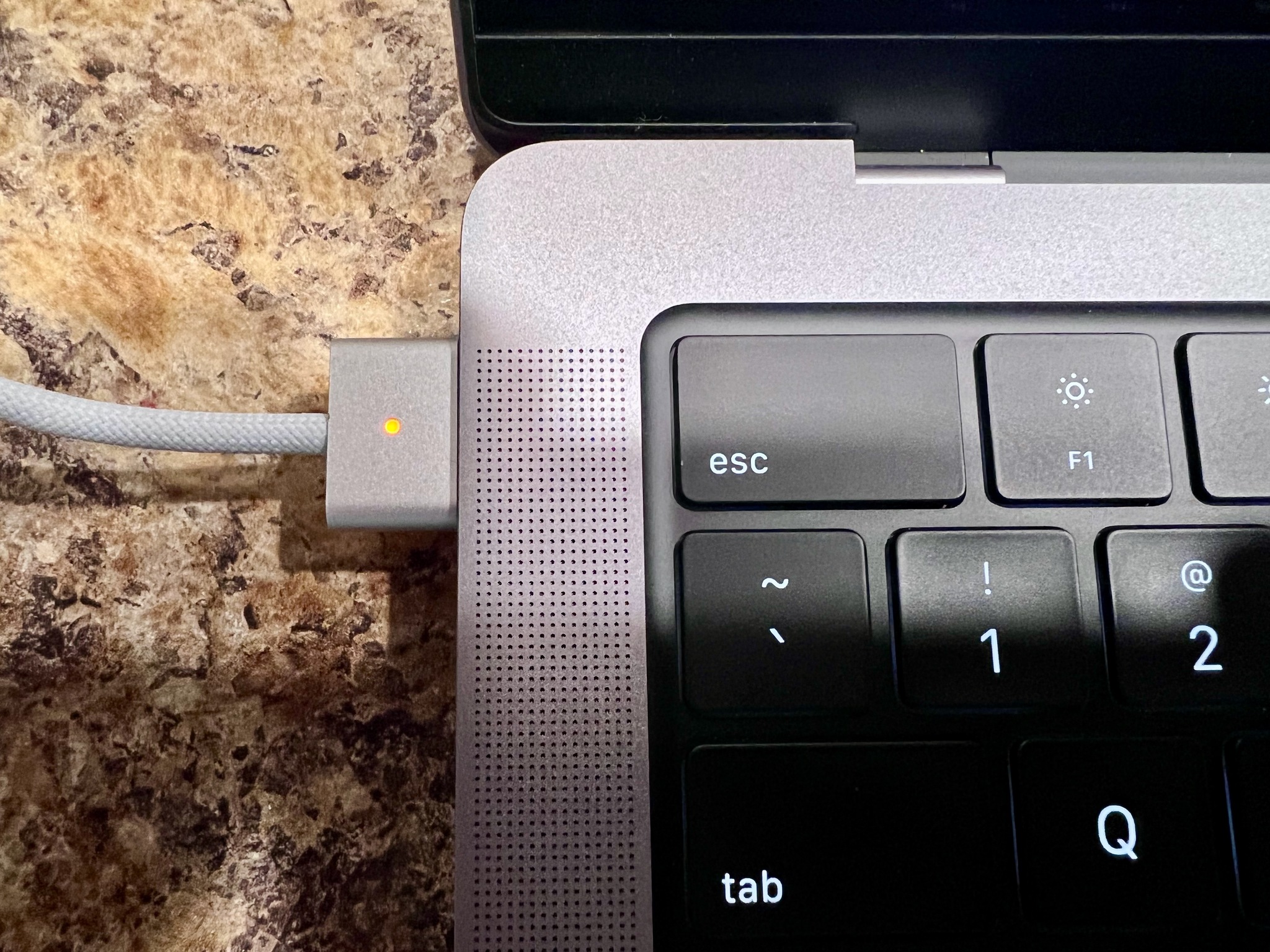
No worries, however. Remember the MagSafe 3? It provides fast charging where 30 minutes is all you need to gain 50% of battery life. To achieve this, owners of the base 14-inch model will need to purchase a 96W-or-higher charger, which is $20 more than the 67W USB-C Power Adapter that comes with this variant. (It's $79 when purchased separately.) The 16-inch model comes with a 140W USB-C Power Adapter.
As is the case with all laptops, these numbers are only estimates and might not get matched in real-world environments. I didn't specifically clock battery life on my 14-inch unit. However, I did recognize it wasn't that often when charging was necessary. And even then, the charging time was minimal.
And that performance hit between A/C and battery power? It was non-existent, which is remarkable and something Apple should tout more often.
MacBook Pro (2021): Webcam and audio
Video calls are no longer something exclusive to business meetings. Apple understands this, which is why it added the new consumer-geared SharePlay feature on FaceTime. On the hardware side, it is also making moves. For the first time, the MacBook Pro has a 1080p webcam after being stuck with 720p for many years. That same camera is extra special since it uses a wider aperture that lets in more light. There's also a large image sensor that delivers better performance than previously.
I can't stress this enough: the M1 on the 13-inch MacBook Pro and MacBook Air (2020) is still impressive and might be more than enough for what you plan on doing.
Apple has also added three studio-quality mics that pick up more sounds. The three-mic array uses directional beamforming, which makes your voice clearer and louder. The 2021 MacBook Pro also includes a new six-speaker sound system. Featuring force-canceling woofers, the speakers provide 80% more bass, with the high-performance tweeters offering clearer, fuller vocals. The impressive sounds are most noticeable when using spatial audio, something Apple's been pushing hard across many devices and headphones.
All these changes are welcome, especially those relating to the webcam and mic. Because headphones are often necessary for many situations, manufacturers and users often see laptop speakers as an afterthought. So Apple's decision to push the speakers on the new MacBook Pro to new levels is respectable. However, it's not a reason to select one laptop over another.
MacBook Pro (2021): Odds and ends
While testing the MacBook Pro, I jotted down a few points that don't fall in the other sections but are still important. Among these:
- It's great to see Apple's moving away from its thinner-is-better approach across multiple product lines. As a result, Apple devices are slightly thicker and heavier than earlier models, from the iPhone and iPad to the MacBook Pro. The 2021 MacBook Pro feels more sturdy and solid because of it, but not to the extent that you can't use it on your lap for long periods.
- Apple should also be commended for again producing a MacBook Pro that isn't addicted to fan noise or heat. Like the 13-inch model, fan noise and heat are kept to a minimum here. Cupertino credits advanced thermal systems for this, which moves 50% more air at lower fan speeds.
- The physical function keys aren't just noted for being full-size. These keys also include must-have keyboard shortcuts for Spotlight, Dictation, Do Not Disturb, and other features. These will make the most ardent Touch Bar supporters forget about it.
- I'll emphasize it again: the notch is no big deal once you weigh the pros and cons. You'll get used to it, and if you can't, use TouchNotch.
- Finally, like recent MacBooks (and other products) before it, the latest Apple product hasn't been designed for user repairs with iFixit giving it a still-unacceptable 4/10 score. And yet, iFixit says the new design is a "major move in the right direction," so that's at least something.
MacBook Pro (2021): Competition
No doubt, there will be a lot written about whether the steep price difference between the 2021 14-inch and 2020 13-inch MacBook Pro is justified. For many, the answer might be a resounding no. Despite being a year older, the well-received 13-inch MacBook Pro still has a lot going for it, starting with its M1 SoC, which continues to do circles around most Intel-based chips. This is also the model you're more likely to find deals during crucial buying seasons when everyone but Apple offers rare discounts.
Before making a choice, check out the differences between the 13-inch and 14-inch MacBook Pros. And if possible, visit an Apple store and look at them side by side.
If you want the 16-inch MacBook Pro, there's no competition — unless you've decided to ditch macOS for Windows 11. If that's the case, you've probably stopped reading this review many lines ago.
MacBook Pro (2021): Should you buy it?
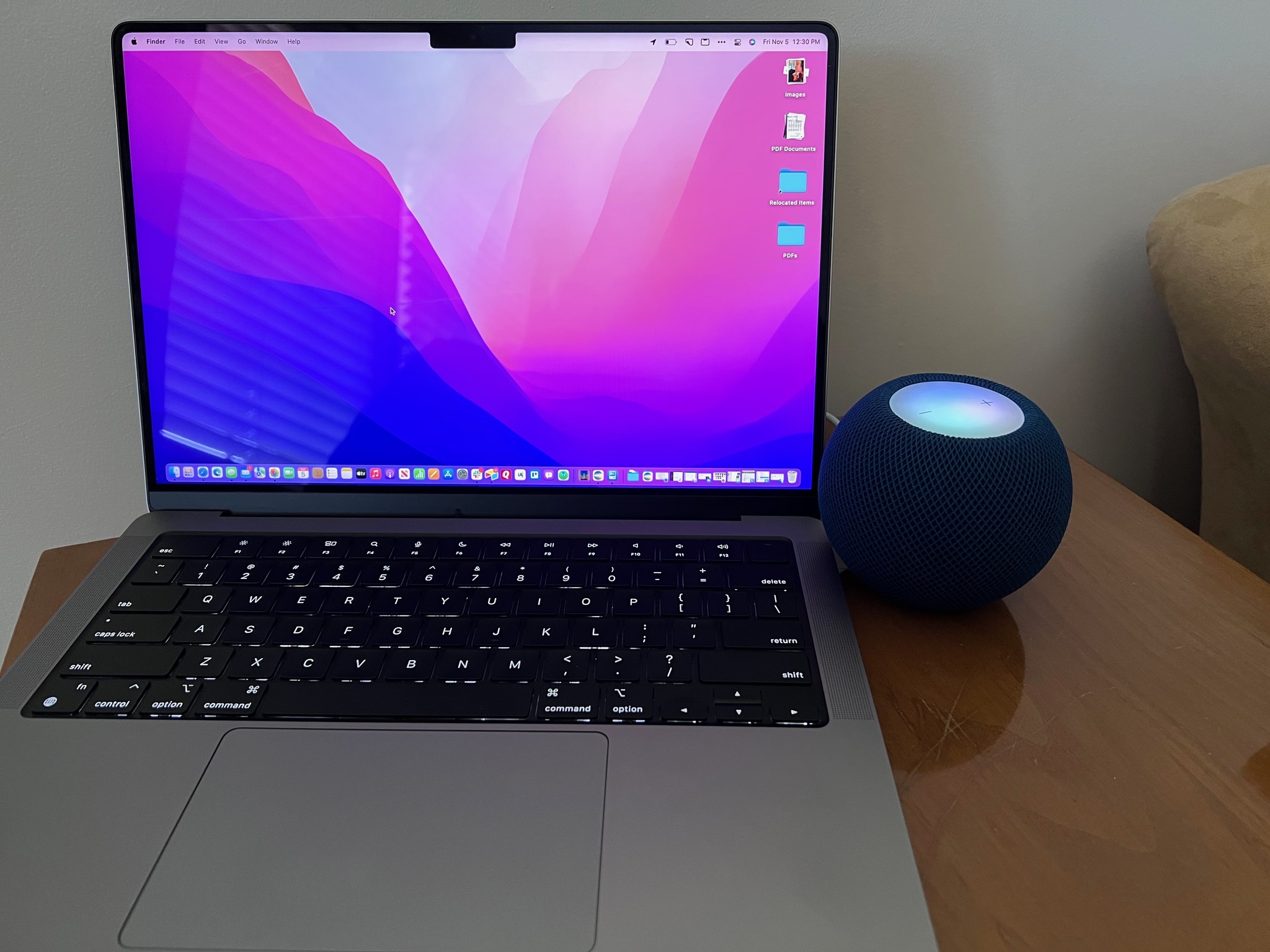
You should buy this if ...
You want the latest and greatest
The 2021 MacBook Pro is the best Mac now on the market because of its impressive display, advanced internals, and other improvements. So if you want the newest Mac on the market, this is it.
Need the power
The M1 Pro and M1 Max build upon the already impressive M1. If you're a professional creator, do your research and decide which SoC is for you. Then, buy the one with the most memory and storage you can afford.
Need ports
Have dongles ruined your workflow? Then, get this laptop and never use a dongle again!
The 2021 MacBook Pro is an impressive beast, and both the 14-inch and 16-inch models are great additions to Apple's laptop lineup. .
You should not buy this if ...
Are on a budget
At $1,999 for the least expensive 2021 MacBook Pro, these are not inexpensive machines. Luckily, short of being a creative who needs the raw power the M1 Pro and M1 Max can provide, you can spend less for a still impressive MacBook Pro.
Don't need the power
I can't stress this enough: the M1 on the 13-inch MacBook Pro and MacBook Air (2020) is still impressive and might be more than enough for what you plan on doing. Therefore, if you live in a work world that's doesn't go beyond spreadsheets, Word documents, and web browsing, this year's MacBook Pro isn't for you.
Want some color
People love colorful Apple products as the current iPad Air, iPad mini, 24-inch iMac, and iPhone 13 show. So if you have grown tired of silver and space gray, don't need a Pro device, and can wait, save your money until next year. The next MacBook Air will almost certainly come in various colors and, better still, is likely to include the M1 successor, perhaps called the "M2."
The 14- and 16-inch models are overkill for most folks, especially when a less expensive Pro model is also available. Regardless, for the first time in five years, Apple has put the Pro back in MacBook Pro, and that's important to creatives of all types that finally have a laptop with the power to do great things.
The 2021 MacBook Pro is an impressive beast, and both the 14-inch and 16-inch models are great additions to Apple's laptop lineup. This year's MacBook Pro packs a punch on multiple fronts, starting with the M1 Pro and M1 Max SoC and continuing with the Liquid Retina XDR display. And because it includes long-retired ports, including MagSafe, it feels like a MacBook Pro, as it should.


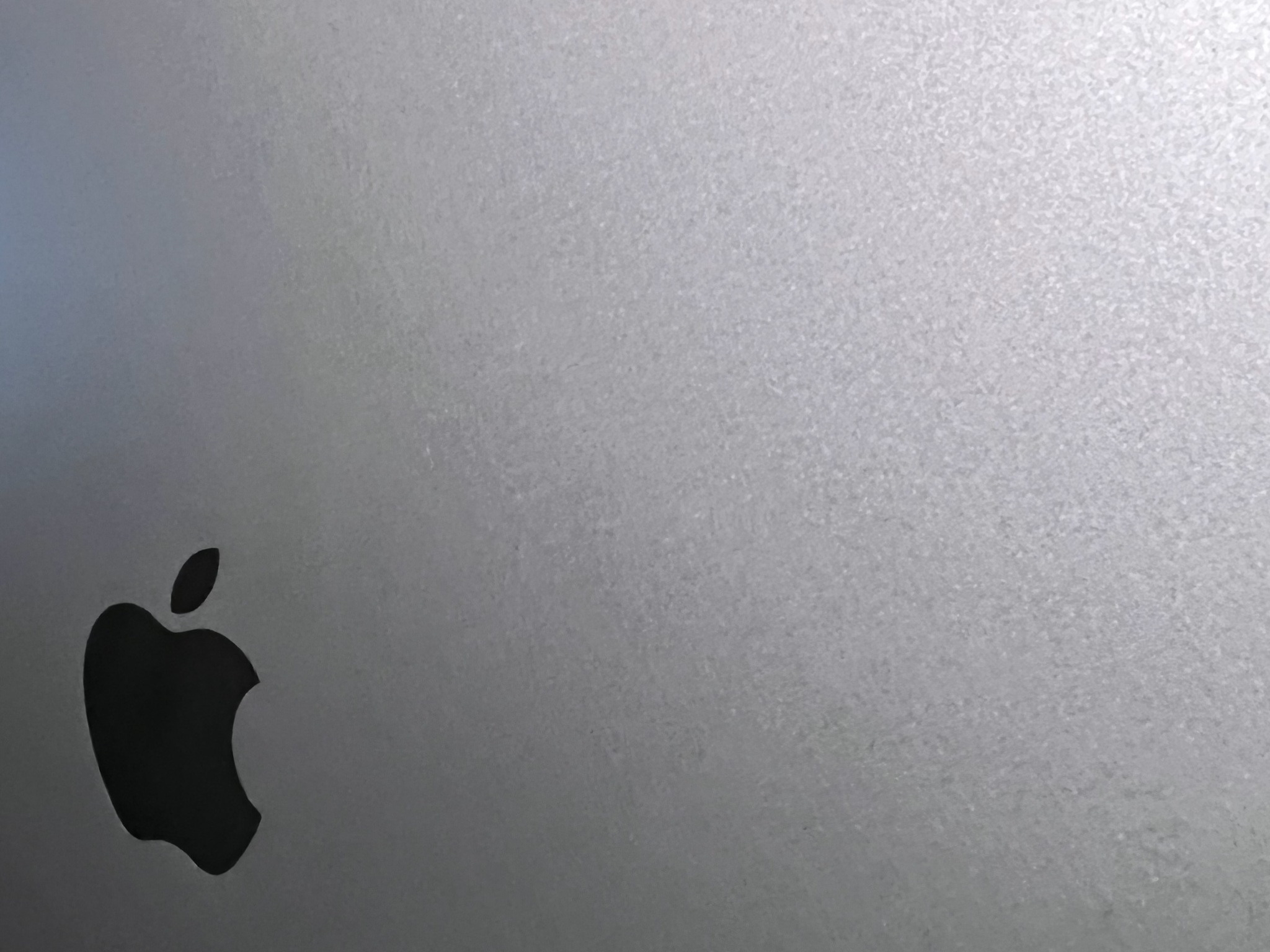



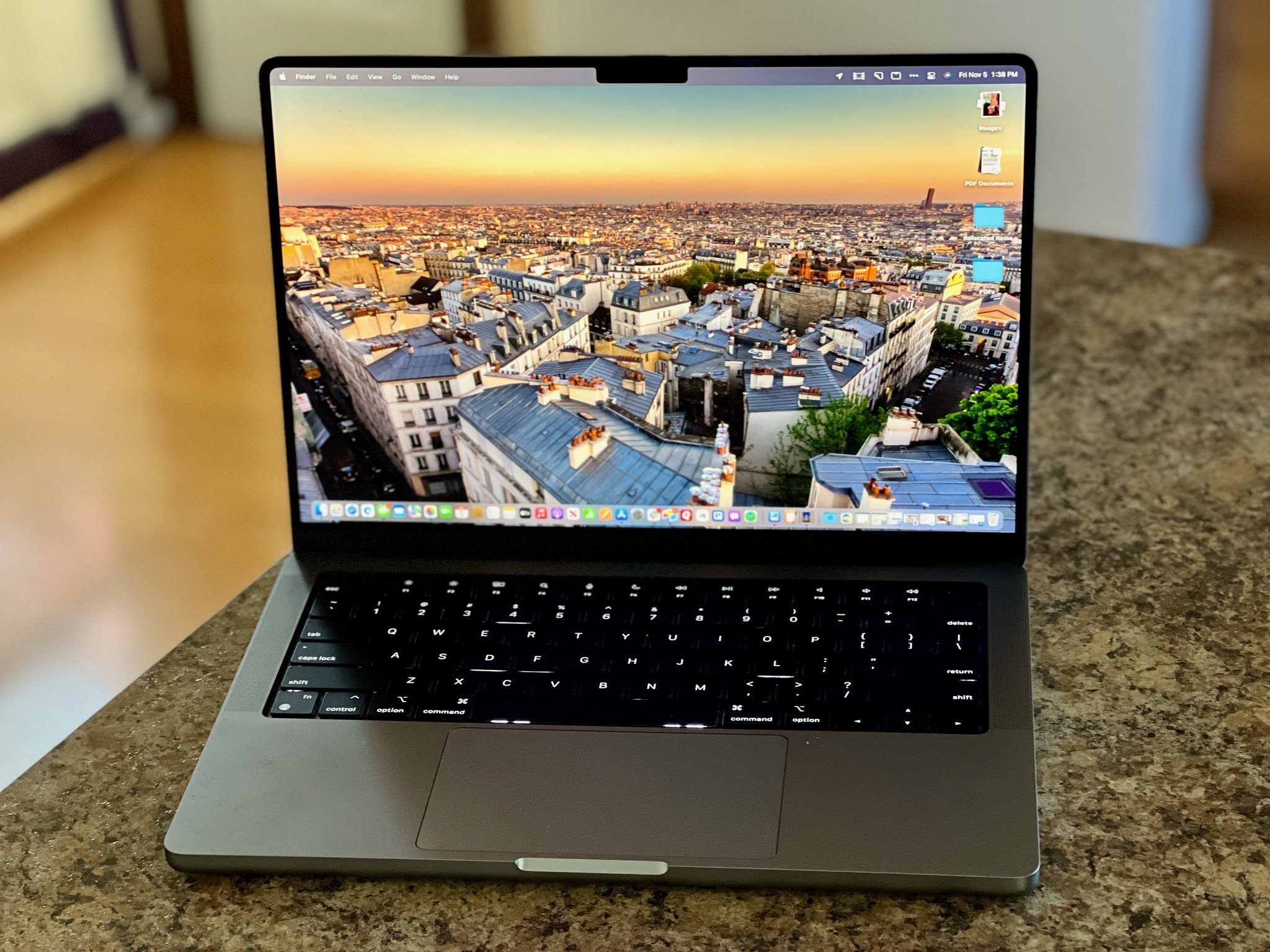


Bryan M. Wolfe has written about technology for over a decade on various websites, including TechRadar, AppAdvice, and many more. Before this, he worked in the technology field across different industries, including healthcare and education. He’s currently iMore’s lead on all things Mac and macOS, although he also loves covering iPhone, iPad, and Apple Watch. Bryan enjoys watching his favorite sports teams, traveling, and driving around his teenage daughter to her latest stage show, audition, or school event in his spare time. He also keeps busy walking his black and white cocker spaniel, Izzy, and trying new coffees and liquid grapes.

